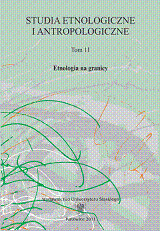Granica - "portret" antropologiczny
The border — an anthropological portrait
Author(s): Halina RusekSubject(s): Anthropology
Published by: Wydawnictwo Uniwersytetu Śląskiego
Summary/Abstract: It is difficult to define the spacious scope of borderland because its only stable point is the borderline. It visibly separates any two parts, two societies with their different systems of values, models and life styles, also often separates “the familiar” from “the foreign”. It is so on the Polish-Czech borderline where the Olza River used to flow through the culturally homogeneous Cieszyn Silesia and currently, as the country borderline, separates two Cieszyn lands going their own and separate ways for over 90 years. Revolutionary changes in Poland and Czech Republic from the turn of the 1980s and 1990s have changed the nature of the borderline which has become the focal point of the most and most intensive transborderline cooperation. Does it mean that the unity of Cieszyn Silesia as a culturally homogeneous and Central European region can return one day? It seems impossible because even the strongest formal relations, administrative actions and intensive mutual contacts will not glue dispersed identities of the inhabitants of both sides of borderland into one Cieszyn identity. Though, the identity of the inhabitants is never homogeneous and clear. It is composed of extremely rich and ethnically diversified material. The people of the borderland move freely from culture to culture, choosing the best contents and models for them, which causes that all dissimilarities are obvious for them and worth acceptance. However these are the people always situated on one side of the border, the one they identify with as their private homeland. The inhabitants of Cieszyn Silesia have two such homelands.
Journal: Studia Etnologiczne i Antropologiczne
- Issue Year: 2011
- Issue No: 11
- Page Range: 77-88
- Page Count: 12
- Language: Polish

